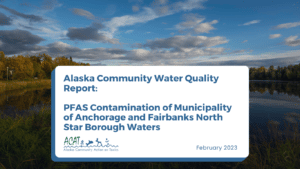Anchorage and Fairbanks Area Waters Contaminated with “Forever Chemicals”

Alaska Community Action on Toxics (ACAT) conducted independent water quality testing in 2022 that showed PFAS (per- and polyfluoroalkyl substances) contamination in Anchorage lakes as well as in Ship Creek.
Alaska Community Action on Toxics (ACAT) conducted independent water quality testing in 2022 that showed PFAS (per- and polyfluoroalkyl substances) contamination in Anchorage lakes as well as in Ship Creek. These results show contamination in lakes used for swimming and fishing. The results also show contamination in Ship Creek downstream from Joint Base Elmendorf and Fort Richardson (JBER), an important urban ecosystem for fish, wildlife, as well as fishing. The samples from 2021 and 2022 revealed the presence of toxic PFAS chemicals in all the water bodies that we tested in both Anchorage and the Fairbanks North Star Borough.
These data emphasize the need for urgent action to protect public health as well as wildlife. The data concerning PFAS in our local lakes are of concern to environmental and public health. The information is a public right-to-know issue.
Our sampling analyses revealed PFAS levels in Anchorage lakes ranging from 10.2 ppt (Sundi Lake) to 952.2 ppt (Lake Spenard). In the Fairbanks North Star Borough, levels ranged from 2.8 ppt (Ballaine Lake) to 179.4 ppt PFAS (Airport Lake). Concentrations in Ship Creek ranged from 4.3 ppt to 32 ppt. Levels of PFAS in Anchorage lakes and Ship Creek are similar to those that triggered fish consumption advisories by the Alaska Department of Fish and Game for certain lakes in the Fairbanks North Star Borough. Levels of PFAS in fish can be several orders of magnitude higher than in the ambient waters because many PFAS are strongly bioaccumulative.
Download the full report here: Alaska Community Water Quality Report: PFAS Contamination of Municipality of Anchorage and Fairbanks North Star Borough Waters
Contact: Adam Ortega, [email protected]; phone, (907) 222-7714
We are calling upon the Alaska State Legislature to enact legislation this session to protect our waters and public health, including provisions that:
- Establish enforceable and health protective drinking water standards for PFAS as a class.
- Phase out the use of PFAS in firefighting foams (AFFF) and other product categories. Safe and effective alternatives to the use of PFAS-based firefighting foams are readily available and in use at major airports, military installations, and oil and gas facilities throughout the world.
- Provide safe, alternative drinking water sources to affected communities.
- Provide medical monitoring for people who have been exposed to PFAS and allow for regular tests and procedures to detect latent diseases or other health impacts.
- Prevent incineration of PFAS wastes and contaminated soils.
- Regulate PFAS as a class and eliminate all non-essential uses of PFAS.
- Require comprehensive monitoring.
The report also urges the legislature to institute a comprehensive monitoring program and establish surface water action levels to protect aquatic life and public health. Currently, there are 469 sites in Alaska where PFAS contamination has been identified in soil and water according to the Alaska Department of Environmental Conservation, and this number is increasing with additional sampling.
PFAS are linked to adverse health outcomes, including liver and kidney damage, reproductive and developmental harm, immune system impairment, and certain cancers. PFAS are toxic at exceedingly low exposure levels. These chemicals have been found in groundwater and public drinking water supplies in communities throughout Alaska due primarily to the dispersive use of PFAS in firefighting foams used by the military and airports. Safe and effective alternatives to the use of PFAS-based firefighting foams are readily available and in use at major airports, military installations, and oil and gas facilities throughout the world.
PFAS (per- and polyfluoroalkyl substances) are a class of more than 12,000 chemicals used in consumer products, industrial applications, and industrial firefighting foams. They are used in numerous consumer products such as food packaging, textiles, apparel, and non-stick cookware due to their stain, grease, and water resistance properties.
“Our family loves to fish. We used to fish in Piledriver Slough, a beautiful stream near Fairbanks,” said Patrice Lee, a mother and teacher in Fairbanks. “We have such wonderful memories of fishing there throughout the summer. It is heartbreaking that we can no longer fish this stream and other lakes in our area because of the PFAS contamination. It is time for our legislators to enact legislation to address PFAS as an urgent public health issue.”
“Alaska is lagging behind other states that are leading the way in enacting legislation to protect the health of their residents and prevent further harm from exposure to PFAS,” said Pamela Miller, executive director of Alaska Community Action on Toxics. “The legislature has the authority and moral imperative to act now in addressing PFAS during this legislative session.”
This month, a PFAS bill was introduced by Alaska Senator Jesse Kiehl titled SB 67: FPAS Use Firefighting. However, the bill only addresses PFAS “relating to firefighting substances, and providing for an effective date,” – ACAT is fighting to make the bill stronger. We believe a more inclusive bill needs to be introduced to protect drinking water and public health in Alaska.
More on PFAS from ACAT:
-
PFAS and PBDEs in traditional subsistence foods from Sivuqaq, Alaska
-
PFAS in drinking water and serum of the people of a southeast Alaska community: A pilot study
-
Exposure to polybrominated diphenyl ethers and perfluoroalkyl substances in a remote population of Alaska Natives
-
Threats to Drinking Water and Public Health in Alaska – The Scope of the PFAS Problem, Consequences of Regulatory Inaction, and Recommendations
